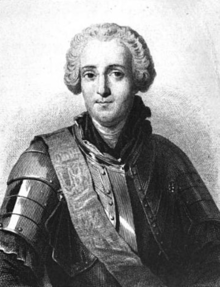François Gaston de Lévis
| François-Gaston de Lévis | |
|---|---|

A 19th-century engraving of Lévis
|
|
| Born |
20 August 1719 Ajac, Aude, France |
| Died | 26 November 1787 (aged 68) Arras, France |
| Allegiance |
|
| Service/branch | French Army |
| Years of service | c. 1735–1783 |
| Rank | Marshal of France |
| Commands held | Commander-in-chief, New France |
| Battles/wars | |
| Other work | Governor of Artois |
War of the Polish Succession
War of the Austrian Succession
François-Gaston de Lévis, Duc de Lévis (20 August 1719 – 20 November 1787), styled as the Chevalier de Lévis until 1785, was a French noble and a Marshal of France. He served with distinction in the War of the Polish Succession and the War of the Austrian Succession.During the Seven Years' War, he was second-in-command to Louis-Joseph de Montcalm in the defense of New France and then, after the surrender of New France in 1760, he served in Europe. After the war, he was appointed Governor of Artois, and in 1783 he was made a Marshal of France.
In 1756, the Marquis de Vaudreuil was informed that King Louis XV of France was sending the Marquis Louis-Joseph de Montcalm to take over French forces in North America, with Lévis as second in command. Vaudreuil wrote back that there was no need to send another general, as Vaudreuil disliked the tactics of most "municipal" French generals. When Montcalm arrived despite Vaudreuil's protest, the two men developed a dislike for each other. Lévis diplomatically cultivated good relations with both men, and managed to avoid getting dragged into the feuds between the two.
Lévis led the vanguard of the French expedition to Fort William Henry in 1757, and laid siege to it until Montcalm's arrival.
During French planning for the 1758 campaign in the French and Indian War the disputes between Vaudreuil and Montcalm continued. Vaudreuil prevailed, and Montcalm was sent to Fort Carillon to defend it against an expected British attack. Lévis was initially slated to lead an expedition to the western forts, leading about 500 French metropolitan troops and a large seasoned French-Canadian militia. Vaudreuil, however, had second thoughts, and dispatched Lévis and his metropolitan troops to support Montcalm at Carillon. Lévis arrived at Carillon on the evening of July 7, as a British army was arriving before the fort. The next day, in a stroke of good fortune for the defenders, the 16,000 strong British army under the command of General James Abercrombie decided to frontally attack the French defenses manned by about 4,000 men, without the benefit of artillery support. In the Battle of Carillon, the British were decisively defeated, with Lévis leading the defense on the French right flank.
...
Wikipedia
